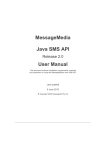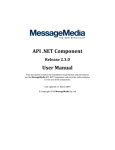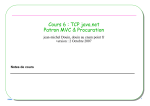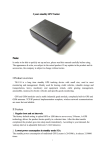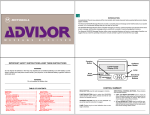Download PHP API Release 2.4 User Manual
Transcript
PHP API
Release 2.4
User Manual
MessageMedia – PHP API Documentation
Last Updated October 8, 2012
Page 1 of 28
Table of Contents
Table of Contents ..................................................................................................................................... 1
Product Information ................................................................................................................................ 3
Introduction ............................................................................................................................................. 4
Supported Platforms ................................................................................................................................ 5
How It Works ........................................................................................................................................... 6
Installation ............................................................................................................................................... 7
Application Development By Example ..................................................................................................... 8
Sending Messages ..................................................................................................................................... 8
Reading Messages ................................................................................................................................... 10
Delivery Reports ....................................................................................................................................... 12
Changing Account Passwords .................................................................................................................. 13
Using A Proxy Server ................................................................................................................................ 15
Account Management ............................................................................................................................. 16
Reporting ................................................................................................................................................. 18
Reference............................................................................................................................................... 23
class SmsInterface.................................................................................................................................... 23
class SmsReply ......................................................................................................................................... 27
class ValidityPeriod .................................................................................................................................. 28
MessageMedia – PHP API Documentation
Last Updated October 8, 2012
Page 2 of 28
Product Information
Product Name
MessageMedia SMS PHP API Release 2.4
Purpose
This document contains the installation and usage
instructions for the MessageMedia SMS PHP API, as well as a
detailed reference.
Prepared by
Matthew Kwan,
MessageMedia Pty Ltd
Release
2.0
2.1
2.2
2.3
2.4
MessageMedia – PHP API Documentation
Last Updated October 8, 2012
4 February 2004
13 June 2006
29 August 2006
14 August 2007
10 October 2012
Page 3 of 28
Introduction
The MessageMedia PHP API is designed to provide access to the MessageMedia SMS
server via a PHP interface. This access includes the sending and receiving of SMS
messages, as well as basic account maintenance.
The API is provided in the form of source code, which should be included in your
applications via the PHP command require("SmsInterface.inc")
MessageMedia – PHP API Documentation
Last Updated October 8, 2012
Page 4 of 28
Supported Platforms
Two versions of the API are provided, supporting different releases of PHP. To benefit
from the full feature set of the API, it is recommended that you use PHP 4.3 or
above.
SmsInterface-40.inc works with PHP 4.0 and above, but uses a number of
deprecated PHP commands, so it should only be used if you have a version of PHP
that is older than 4.2
SmsInterface.inc works with PHP 4.2 and above, and is the recommended version.
Note, however, that releases of PHP prior to 4.3 will not support encrypted
communications with the MessageMedia server via SSL, so it is recommended that
you upgrade to the 4.3 release to take full advantage of this API.
Because PHP is an interpreted language, PHP applications will run on any machine
that has an interpreter installed. PHP interpreters are available for Linux, Windows
NT, and all variants of Unix. For a complete list of the supported operating systems
and downloadable copies of their interpreters visit http://www.php.net
MessageMedia – PHP API Documentation
Last Updated October 8, 2012
Page 5 of 28
How It Works
The API provides a wrapper for communicating with the MessageMedia SMS server
via port 80 (or port 443 for encrypted SSL communications), either directly or via a
proxy server.
The first step is to contact a list of active SMS servers in sequence until there is a
positive response from one of them. Having found an active server, the API will then
send through a username and password for authentication, then issue a command
and extract information from the server's response.
MessageMedia – PHP API Documentation
Last Updated October 8, 2012
Page 6 of 28
Installation
If you are running PHP 4.2 or above, you should install the file SmsInterface.inc. If
you are running an older version, install the file SmsInterface-40.inc instead, but
rename it to SmsInterface.inc
Since the file is distributed as source code, it can be installed anywhere that your
PHP interpreter has read access. For convenience, we suggest that you install it in
the same directory as the PHP application that will be using it.
If your system does not have a PHP interpreter installed, visit http://www.php.net to
download the latest version and follow the installation instructions provided.
MessageMedia – PHP API Documentation
Last Updated October 8, 2012
Page 7 of 28
Application Development By Example
The following section will explain how to use the API through the use of examples. A
more detailed description of the individual API components can be found in the
Reference section.
Sending Messages
<HTML>
<HEAD><TITLE> SMS sending results </TITLE></HEAD>
<BODY>
<?php
require ("SmsInterface.inc");
echo "<P> Message sent to <B>" . $_POST["phone"] . "</B> ";
$si = new SmsInterface (false, false);
$si->addMessage ($_POST["phone"], $_POST["message"]);
if (!$si->connect ($_POST["username"], $_POST["password"], true,
false))
echo "failed. Could not contact server.\n";
elseif (!$si->sendMessages ()) {
echo "failed. Could not send message to server.\n";
if ($si->getResponseMessage () !== NULL)
echo "<BR>Reason: " . $si->getResponseMessage () . "\n";
} else
echo "OK.\n";
?>
</BODY>
</HTML>
This is an example of a PHP script that would be called from a web server. The script
will connect to the MessageMedia server and send out a single SMS message to a
specified phone number. The source code for this script can be found in the
examples directory of this distribution under the name sendsms.php. It could be
called from the following HTML script (which is also included in the examples
directory under the name sendsmsform.html).
<HTML>
<HEAD><TITLE> Send SMS </TITLE></HEAD>
<BODY>
<FORM ACTION="sendsms.php" METHOD="POST">
Username: <INPUT TYPE="text" NAME="username" SIZE="10"> <BR>
Password: <INPUT TYPE="password" NAME="password" SIZE="10"> <BR>
Phone number: <INPUT TYPE="text" NAME="phone" SIZE="13"> <BR>
Message:
<INPUT TYPE="text" NAME="message" SIZE="80" MAXLENGTH="160"> <BR>
<INPUT TYPE="submit" VALUE="Send">
</FORM>
</BODY>
</HTML>
MessageMedia – PHP API Documentation
Last Updated October 8, 2012
Page 8 of 28
In the PHP code, the line require ("SmsInterface.inc"); includes the API and is
needed by every application that wishes to use it.
The API uses an object-oriented design, whose main class is SmsInterface. The
constructor for this class takes two optional parameters - autoSplit which specifies
whether message splitting will take place (a boolean value, which is optional and
defaults to false), and concatenate which specifies that message concatenation will
take place (also boolean, defaulting to false). These parameters are used to decide
how to treat messages greater than 160 characters in length. If both are false, all
such messages will be truncated to 160 characters. However, if autoSplit is true,
long messages will be split into separate messages smaller than 160 characters and
delivered at 30 second intervals, while if concatenate is true, long messages will be
concatenated into a single long message using an extension to the GSM protocol.
Note that this extension may not work on older phones.
The $si->addMessage() function adds a message to an internal list. You can add as
many messages as you like, and they will be sent in a batch when $si>sendMessages() is called. However, it is recommended that you send batches of
no more than 200 messages, to minimize both the time it takes to complete the task
and the chance that a network or server error will cause the batch to fail. Note that if
there is an error, no messages from the batch will be sent, so it is safe to re-send
the entire batch.
In the example above, the addMessage function is taking phone number and
message parameters, both strings. You can also specify extra parameters, setting a
message ID, scheduled delay, validity period, and whether a delivery report is
required. For details, see the Reference section of this document.
The $si->connect() call attempts to make a connection to the Messagemedia SMS
server. The first two parameters are the username and password for your account.
The third parameter determines whether message IDs will be used (even if you don't
use them, as in this example, we recommend setting the parameter true anyway).
The fourth parameter is used to select a secure SSL connection with the server, but
please note that a true value will not work with PHP versions prior to 4.3.
If the connection is successful, we then send the messages with the $si>sendMessages() command. Note that this command will close the connection
before returning, so you must re-connect if you wish to issue any other commands to
the server. If this call fails, the server may provide a reason, which we can access
via the $si->getResponseMessage() function.
MessageMedia – PHP API Documentation
Last Updated October 8, 2012
Page 9 of 28
Reading Messages
<HTML>
<HEAD><TITLE> Messages retrieved from server </TITLE></HEAD>
<BODY>
<?php
require ("SmsInterface.inc");
$si = new SmsInterface ();
if (!$si->connect ($_POST["username"], $_POST["password"], true,
false))
echo "<P> Unable to connect to the SMS server.\n";
elseif (($srl = $si->checkReplies ()) === NULL) {
echo "Unable to read messages from the SMS server.\n";
if ($si->getResponseMessage () !== NULL)
echo "<BR>Reason: " . $si->getResponseMessage() . "\n";
} elseif (count ($srl) == 0)
echo "No messages waiting on the SMS server.\n";
else {
echo "<TABLE><TR>”
echo “<TH> Message ID <TH> Phone number <TH> Message\n";
foreach ($srl as $sr) {
echo "<TR><TD> $sr->messageID <TD> $sr->phoneNumber <TD> ";
if ($sr->status == MessageStatus::none ())
echo "$sr->message\n";
elseif ($sr->status == MessageStatus::pending ())
echo "Message delivery pending\n";
elseif ($sr->status == MessageStatus::delivered ())
echo "Message successfully delivered\n";
elseif ($sr->status == MessageStatus::failed ())
echo "Message delivery failed\n";
else
echo "Unknown message status '$sr->status'\n";
}
echo "</TABLE>\n";
}
?>
</BODY>
</HTML>
The above script will connect to the Messagemedia server, using a username and
password specified in the calling form, and display all the previously-unread replies
in a table. The source code for this script can be found in the examples directory
under the name readsms.php.
After connecting to the server with the $si->connect() call, the $si>checkReplies() call will return an array of SmsReply objects and close the
connection to the server. Note that if there is a problem, such as an incorrect
password, this function will return NULL, while a successful connection with no replies
will return an empty array. You should test for a NULL return by comparing with the
MessageMedia – PHP API Documentation
Last Updated October 8, 2012
Page 10 of 28
=== operator. Do not use the == operator, since it will not distinguish between NULL
and an empty array.
The checkReplies() function takes an optional boolean parameter, defaulting to
true, which causes the function to automatically confirm with the server that the
replies have been received successfully. Once this confirmation is received, the
server will mark the replies as read, and they will not be downloaded the next time
this function is called. However, if the parameter is set to false, the replies will not
be marked as read on the server until there is an explicit call to
confirmRepliesReceived(). This can be useful if you want to make certain that the
replies have been successfully saved or processed before flagging them as read.
Some code to do this might look like this (plus some error checks).
$si->connect ("username", "password", true, false);
$srl = $si->checkReplies (false);
if (processReplies ($srl)) {
$si->connect ("username", "password", true, false);
$si->confirmRepliesReceived ();
}
The SmsReply class contains a messageID field, which corresponds to the message ID
of the message that it is replying to. The phoneNumber and message fields are selfevident. The status field is used to indicate delivery reports, which may be received if
you previously sent a message that requested one. The SmsReply class also has
another field not shown, $sr->when, which indicates how many seconds ago the
reply was received. See the Reference section for further details
MessageMedia – PHP API Documentation
Last Updated October 8, 2012
Page 11 of 28
Delivery Reports
When sending an SMS, it is possible to request a delivery report from the network.
This is done by setting the 6th parameter of the $si->addMessage() to true.
However, it should be noted that messages requesting delivery reports cost more to
send than regular messages. Please contact MessageMedia Pty Ltd for detailed
pricing information.
When the SMS is successfully sent (but not yet received), a delivery report will be
sent to your account by the telecommunications carrier. This report can be retrieved
via the checkReplies function, where it will appear in the form of an SmsReply where
the field $sr->status is equal to MessageStatus::pending().
When the SMS is successfully delivered – or if it cannot be delivered for some
reason, a second delivery report will be sent to your account. Again, this will take the
form of an SmsReply, with a status of either MessageStatus::delivered() or
MessageStatus::failed().
MessageMedia – PHP API Documentation
Last Updated October 8, 2012
Page 12 of 28
Changing Account Passwords
<HTML>
<HEAD><TITLE> Change password result </TITLE></HEAD>
<BODY>
<?php
require ("SmsInterface.inc");
$si = new SmsInterface ();
if (!$si->connect ($_POST["username"], $_POST["password"], true,
false))
echo "<P> Unable to connect to the SMS server.\n";
elseif (!$si->changePassword ($_POST["newpassword"])) {
echo "Unable to change the password for ";
echo $_POST["username"] . "\n";
if ($si->getResponseMessage () !== NULL)
echo "<BR>Reason: " . $si->getResponseMessage() . "\n";
} else {
echo "Successfully changed the password for ”;
echo $_POST["username"] . "\n";
}
?>
</BODY>
</HTML>
The above script will connect to the Messagemedia server and change the password
for the user's account. The source code for this script can be found in the examples
directory under the name password.php.
The $si->changePassword() function takes the new password as its argument,
which it passes to the server before closing the connection.
MessageMedia – PHP API Documentation
Last Updated October 8, 2012
Page 13 of 28
Checking Remaining Credits
<HTML>
<HEAD><TITLE> Credits remaining </TITLE></HEAD>
<BODY>
<?php
require ("SmsInterface.inc");
$si = new SmsInterface ();
if (!$si->connect ($_POST["username"], $_POST["password"], true,
false))
echo "<P> Unable to connect to the SMS server.\n";
else {
$cr = $si->getCreditsRemaining ();
if ($cr == -2) {
echo "Unable to read credits for " . $_POST["username"];
echo " from the SMS server.\n";
if ($si->getResponseMessage () !== NULL)
echo "<BR>Reason: " . $si->getResponseMessage() . "\n";
} elseif ($cr == -1) {
echo "The account for " . $_POST["username"];
echo " is not a pre-paid account.\n";
} else {
echo "The account for " . $_POST["username"];
echo " has $cr credits remaining.\n";
}
}
?>
</BODY>
</HTML>
The above script will connect to the Messagemedia server and return the number of
credits remaining for the user's account. The source code for this script can be found
in the examples directory under the name credits.php.
The $si->getCreditsRemaining() function retrieves the number of credits
remaining, then closes the connection. If there is a problem retrieving the
information, the function returns -2, and may set the response message to specify
the reason. The function returns -1 if the user does not have a pre-paid account,
since post-paid accounts do not have credits remaining.
MessageMedia – PHP API Documentation
Last Updated October 8, 2012
Page 14 of 28
Using A Proxy Server
If your PHP application operates in an environment where all HTTP communications
must go via a proxy server, you will need to call the $si->setHttpProxy() function.
This should be done after creating an SmsInterface object, but before doing the
connect() call. Assuming your proxy’s name is proxy.yourcompany.com, and you
connect via port 80, and the proxy doesn’t require authentication, the code would
look something like this.
$si = new SmsInterface ();
$si->setHttpProxy ("proxy.yourcompany.com", 80);
if (!$si->connect ($_POST["username"], $_POST["password"], true,
false))
If you are using the secure SSL option and HTTPS communications go via a proxy
server, you will need to call the setHttpsProxy() function. Assuming this is done via
port 443, and the proxy server authenticates with username “john” and password
“xx”, the code might look like this.
$si = new SmsInterface (2);
$si->setHttpsProxy ("proxy.yourcompany.com", 443, "john", "xx");
MessageMedia – PHP API Documentation
Last Updated October 8, 2012
Page 15 of 28
Account Management
The MMAccountManagement class provides access to limited account management
functionality. The class must be instantiated with the username and password of an
account that is authorised to produce reports. For example:
$acctMgmt = new MMAccountManagement(“username”, “password”);
The MMAccountManagement class provides the following methods:
createNewUser
setUserCreditLimit
getUserCreditLimit
All of these methods follow the convention that errors are indicated by returning
false, in which case the getLastError() method can be used to retrieve an error
string.
Create New User
The createNewUser methods creates a new gateway user.
Parameters:
customerId
contactName
contactPhone
contactEmail
newUser
isAdmin
creditLimit
Customer to create the new user for (required)
Contact name for the new user (required)
Contact phone number for the new user. Expected to be in full
international format (without the preceding +). (required)
Contact email address for the new user (required)
Username for the new user, used as a return variable.
Usernames for new users are automatically generated, so
setting this will have no effect. (return variable)
Boolean indicating whether or not the new user is an admin for
the customer. (optional, default = false)
Credit limit for the new user (optional).
Return value:
If the new user was created successfully, this method will return true. Otherwise it
will return false, and the getLastError() method can be used to diagnose the
problem.
Setting A Users Credit Limit
Set setUserCreditLimit the details of a user's credit limits.
Parameters:
username
currentLimit
Username for which to update the credit limit. (required)
Credit limit to apply. Set to NULL to leave unchanged. (required)
Return value:
If the credit limit configuration was updated successfully, this method will return
true. Otherwise it will return false, and the getLastError() method can be used to
MessageMedia – PHP API Documentation
Last Updated October 8, 2012
Page 16 of 28
diagnose the problem.
Getting A Users Credit Limit
Fetch the details of a user's credit limits by calling getUserCreditLimit. Values are
returned via return variables (passed in by reference).
Note that you should use SmsInterface::getCreditsRemaining() to get the details
for credits remaining.
Parameters:
username
currentLimit
Username for which to update the credit limit. (required)
Credit limit that will apply. Set to NULL to leave
unchanged.(required, return variable)
Return value:
If the credit limit configuration was retrieved successfully, this method will return
true. Otherwise it will return false, and the getLastError() method can be used to
diagnose the problem.
Getting A Users ID
Fetch the ID of a user from a username by calling getUserId.
Parameters:
username
Username for which to update the credit limit. (required)
Return value:
If the user ID was retrieved successful this method will return the user ID. Otherwise
it will return false.
MessageMedia – PHP API Documentation
Last Updated October 8, 2012
Page 17 of 28
Reporting
The MMReporting class provides access to User-level and Customer-level reporting
functionality. The class must be instantiated with the username and password of an
account that is authorised to produce reports. For example:
$reporting = new MMReporting(“username”, “password”);
Note that usernames are case sensitive.
The MMReporting class provides the following methods:
showReportForUser
showReportForCustomer
showSummaryReportForUser
showSummaryReportForCustomer
showCsvReportForUser
showCsvReportForCustomer
All of these methods follow the convention that optional parameters can be omitted
by passing NULL as an argument. Errors are indicated by returning NULL, in which
case the getLastError() method can be used to retrieve an error string.
This API is limited to returning 10,000 records.
User Reporting
The showReportForUser method returns an array containing a report of all of the
messages sent or received for a user over a given period.
Parameters:
userId
rangeStart
rangeLimit
messageType
timezone
broadcast
broadcastFields
timestampBegin
timestampEnd
UID of the user to be reported on. (required)
Index of the first row to be returned (from the complete result
set). (optional, default is 0)
Number of rows to be returned. Valid range is 1-10000.
(optional, default is 50)
Kind of messages to report on. 'S' for sent or 'R' for received.
(optional, default is 'S').
Timezone identifier (e.g. America/Los_Angeles). Timezone
identifiers use the PHP timezone format, which is case-sensitive.
(optional, default is set in Manager).
Whether to show broadcast messages for a single broadcast or
all broadcasts. 'ALL' is used to show messages for all
broadcasts. A broadcast URN is used to show messages for a
specific broadcast (optional, default is 'ALL').
An array of fields that should be reported. (optional)
Timestamp for the beginning of the range to reporting on. The
format is 'YYYY-MM-DD HH:MM:SS'. (optional)
Timestamp for the beginning of the range to reporting on. The
format is 'YYYY-MM-DD HH:MM:SS'. (optional)
Return value:
MessageMedia – PHP API Documentation
Last Updated October 8, 2012
Page 18 of 28
If the API call is successful, this method returns a PHP array. If the call is
unsuccessful, this method will return NULL and set an internal error code. The
getLastError() method can be used to retrieve a error string that can be used to
diagnose the error.
Customer Reporting
The showReportForCustomer method returns an array containing a report of all of
the messages sent or received for a customer over a given period.
Parameters:
customerId
rangeStart
rangeLimit
messageType
timezone
timestampBegin
timestampEnd
ID of the customer to be reported on. (required)
Index of the first row to be returned (from the complete result
set).
(optional, default is 0)
Number of rows to be returned. Valid range is 1-10000. (optional,
default is 50)
Kind of messages to report on. 'S' for sent or 'R' for received.
(optional, default is 'S').
Timezone identifier (e.g. America/Los_Angeles). Timezone
identifiers use the PHP timezone format, which is case-sensitive.
(optional, default is set in Manager).
Timestamp for the beginning of the range to reporting on. The
format is 'YYYY-MM-DD HH:MM:SS'. (optional)
Timestamp for the beginning of the range to reporting on. The
format is 'YYYY-MM-DD HH:MM:SS'. (optional)
Return value:
If the API call is successful, this method returns a PHP array. If the call is
unsuccessful, this method will return NULL and set an internal error code. The
getLastError() method can be used to retrieve a error string that can be used to
diagnose the error.
User Summary Reporting
The showSummaryReportForUser method returns an array containing a summarised
report of all of the messages sent or received for a user over a given period.
Parameters:
userId
messageType
timezone
broadcast
broadcastFields
timestampBegin
UID of the user to be reported on. (required)
Kind of messages to report on. 'S' for sent or 'R' for received.
(optional, default is 'S').
Timezone identifier (e.g. America/Los_Angeles). Timezone
identifiers use the PHP timezone format, which is case-sensitive.
(optional, default is set in Manager).
Whether to show broadcast messages for a single broadcast or
all broadcasts. 'ALL' is used to show messages for all broadcasts.
A broadcast URN is used to show messages for a specific
broadcast (optional, default is 'ALL').
An array of fields that should be reported. (optional)
Timestamp for the beginning of the range to reporting on. The
MessageMedia – PHP API Documentation
Last Updated October 8, 2012
Page 19 of 28
timestampEnd
groupType
groupName
format is 'YYYY-MM-DD HH:MM:SS'. (optional)
Timestamp for the beginning of the range to reporting on. The
format is 'YYYY-MM-DD HH:MM:SS'. (optional)
How to group results. Usually, this should be set to 'date'. If
broadcast or broadcastField are set, then this parameter can also
be set to either 'broadcast' or 'broadcastField'. (required)
Used when groupType is 'date' or 'broadcastField'. When
groupType is 'date', valid values are: 'month', 'week', 'date'.
When groupType is 'broadcastField' this should be the name of a
broadcast field. (optional, defaults to 'date')
Return value:
If the API call is successful, this method returns a PHP array. If the call is
unsuccessful, this method will return NULL and set an internal error code. The
getLastError() method can be used to retrieve a error string that can be used to
diagnose the error.
Customer Summary Reporting
The showSummaryReportForCustomer method returns an array containing a
summarised report of all of the messages sent or received for a customer over a
given period.
Parameters:
customerId
messageType
timezone
timestampBegin
timestampEnd
groupType
groupName
ID of the customer to be reported on. (required)
Kind of messages to report on. 'S' for sent or 'R' for received.
(optional, default is 'S').
Timezone identifier (e.g. America/Los_Angeles). Timezone
identifiers use the PHP timezone format, which is case-sensitive.
(optional, default is set in Manager).
Timestamp for the beginning of the range to reporting on. The
format is 'YYYY-MM-DD HH:MM:SS'. (optional)
Timestamp for the beginning of the range to reporting on. The
format is 'YYYY-MM-DD HH:MM:SS'. (optional)
How to group results. Usually, this should be set to 'date'.
(required)
Used when groupType is 'date' or 'broadcastField'. When
groupType is 'date', valid values are: 'month', 'week', 'date'.
(optional, defaults to 'date')
Return value:
If the API call is successful, this method returns a PHP array. If the call is
unsuccessful, this method will return NULL and set an internal error code. The
getLastError() method can be used to retrieve a error string that can be used to
diagnose the error.
User Reporting (CSV)
The showCsvReportForUser method returns a string containing a CSV-formatted
report of all of the messages sent or received for a user over a given period.
MessageMedia – PHP API Documentation
Last Updated October 8, 2012
Page 20 of 28
Parameters:
userId
messageType
timezone
broadcast
broadcastFields
timestampBegin
timestampEnd
UID of the user to be reported on. (required)
Kind of messages to report on. 'S' for sent or 'R' for received.
(optional, default is 'S').
Timezone identifier (e.g. America/Los_Angeles). Timezone
identifiers use the PHP timezone format, which is case-sensitive.
(optional, default is set in Manager).
Whether to show broadcast messages for a single broadcast or
all broadcasts. 'ALL' is used to show messages for all broadcasts.
A broadcast URN is used to show messages for a specific
broadcast (optional, default is 'ALL').
An array of fields that should be reported. (optional)
Timestamp for the beginning of the range to reporting on. The
format is 'YYYY-MM-DD HH:MM:SS'. (optional)
Timestamp for the beginning of the range to reporting on. The
format is 'YYYY-MM-DD HH:MM:SS'. (optional)
Return value:
If the API call is successful, this method returns a string containing CSV-formatted
data. If the call is unsuccessful, this method will return NULL and set an internal error
code. The getLastError() method can be used to retrieve a error string that can be
used to diagnose the error.
Customer Reporting (CSV)
The showCsvReportForCustomer method returns a string containing a CSVformatted report of all of the messages sent or received for a user over a given
period.
Parameters:
customerId
messageType
timezone
timestampBegin
timestampEnd
ID of the customer to be reported on. (required)
Kind of messages to report on. 'S' for sent or 'R' for received.
(optional, default is 'S').
Timezone identifier (e.g. America/Los_Angeles). Timezone
identifiers use the PHP timezone format, which is casesensitive. (optional, default is set in Manager).
Timestamp for the beginning of the range to reporting on. The
format is 'YYYY-MM-DD HH:MM:SS'. (optional)
Timestamp for the beginning of the range to reporting on. The
format is 'YYYY-MM-DD HH:MM:SS'. (optional)
Return value:
If the API call is successful, this method returns a string containing CSV-formatted
data. If the call is unsuccessful, this method will return NULL and set an internal
error code. The getLastError() method can be used to retrieve a error string that
can be used to diagnose the error.
Troubleshooting
MessageMedia – PHP API Documentation
Last Updated October 8, 2012
Page 21 of 28
Some of these PHP API functions can return a large amount of data. If you
experience PHP out-of-memory errors it may be necessary to increase the
memory_limit value in your php.ini file.
Notes
Please contact MessageMedia support to get your customer ID.
Please use the getUserId function in the MMAccountManagement class to get a user
ID from a username.
MessageMedia – PHP API Documentation
Last Updated October 8, 2012
Page 22 of 28
Reference
class SmsInterface
SmsInterface (
$autoSplit,
$concatenate
);
// Boolean, optional, default = false
// Boolean, optional, default = false
The SmsInterface constructor takes two parameters, which specify how long
messages will be sent.
If both the autoSplit and concatenate parameters are false, all long messages will
be truncated to 160 characters. However, if autoSplit is true, long messages will be
split into separate messages smaller than 160 characters and delivered at 30 second
intervals, while if concatenate is true, long messages will be concatenated into a
single long message using an extension to the GSM protocol. Note that this
extension may not work on older phones.
$si->connect (
$username,
$password,
$useMessageID,
$secure
);
//
//
//
//
String
String
Boolean
Boolean
The $si->connect() call attempts to make a connection to the MessageMedia SMS
server. The first two parameters are the username and password for the account.
The third parameter determines whether message IDs will be used (even if you don't
use them, it is recommend that this parameter be set true anyway). The fourth
parameter is used to select a secure SSL connection with the server, but note that a
true value will not work with PHP versions prior to 4.3.
This function returns a boolean value, true on success, false on failure.
$si->getResponseCode ();
This function returns the integer response code received from calls to
changePassword, getCreditsRemaining, sendMessages, and checkReplies. A value
of -1 indicates that no response code has been received from the server.
Values in the 100-199 range indicate success. 400-499 indicate temporary errors
(e.g. network down), while 500-599 indicate permanent errors (e.g. wrong
password). Some common values are:
400
500
510
520
Server error
Syntax error (due to an error in the API communications)
Incorrect password
Insufficient daily credit
MessageMedia – PHP API Documentation
Last Updated October 8, 2012
Page 23 of 28
540 Insufficient credit
$si->getResponseMessage ();
This function returns the response message received from calls to changePassword,
getCreditsRemaining, sendMessages, and checkReplies. A value of NULL indicates
that no response code has been received from the server. The messages correspond
to the codes returned by $si->getResponseCode().
$si->addMessage (
$phone,
$messageText,
$messageID,
$delay,
$validityPeriod,
$deliveryReport
);
//
//
//
//
//
//
String
String
Integer,
Integer,
Integer,
Boolean,
optional,
optional,
optional,
optional,
default
default
default
default
=
=
=
=
0
0
169
false
The $si->addMessage() function adds a message to an internal list. You can add as
many messages as you like, and they will be sent in a batch when $si>sendMessages() is called. However, it is recommended that you send batches of
no more than 200 messages, to minimize both the time it takes to complete the task
and the chance that a network or server error will cause the batch to fail.
The $phone parameter is a string containing the phone number. This can be a localformat Australian mobile number (e.g. 0410123456), an international-format
Australian mobile number (e.g. 61410123456), or a full international number (e.g.
+447746123456). Any spaces and non-numeric characters will be stripped out
before processing, so it is safe to separate the digits by spaces.
The $messageText contains the message to be sent. If it is over 160 characters, it
will either be truncated (default), split into separate messages if the constructor sets
the $allowSplitting parameter true, or concatenated into a long message if
$concatenate is true.
The $messageID is an integer that will be passed back if there are any replies to this
message. Careful selection of this value can allow messages to be correlated with
replies.
The $delay parameter is an integer that specifies how many seconds in the future
the message should be delivered.
The $validityPeriod parameter specifies how long the SMS network should keep
trying to deliver the message if the recipient's phone is not responding. Suitable
values are specified in the ValidityPeriod class. The default value is 3 days.
If the $deliveryReport parameter is set true, the SMS network will send a delivery
report when the message is received by the network, and again when the message is
either successfully delivered, or discarded after the validity period expires.
MessageMedia – PHP API Documentation
Last Updated October 8, 2012
Page 24 of 28
This function does not return any value.
$si->addVoiceMessage (
$phone,
$messageText,
$messageID,
$delay
);
//
//
//
//
String
String
Integer, optional, default = 0
Integer, optional, default = 0
The $si->addVoiceMessage() causes the $phone parameter to be called, and the
contents of $messagesText read in a synthesis voice. Because the message is not
sent as an SMS the phone number can be a landline number.
The parameters to addVoiceMessage() are identical to addMessage(), except that
the $validityPeriod and $deliveryReport parameters are not specified, and the
message text can be up to 255 characters.
This function does not return any value.
$si->sendMessages ();
The $si->sendMessages() function sends to the MessageMedia server all the
messages that have been previously added with $si->addMessage(). Note that this
command will close the connection before returning.
This function returns a boolean value, true on success, false on failure. In the case of
failure, the reason may be provided by the getResponseCode and
getResponseMessage functions.
$si->changePassword (
$newPassword
);
// String
This command changes the account's password to the specified value, and closes the
connection to the server before returning.
The function returns a boolean value, true on success, false on failure. In the case of
failure, the reason may be provided by the getResponseCode and
getResponseMessage functions.
$si->getCreditsRemaining ();
The $si->getCreditsRemaining() function retrieves the number of credits
remaining, then closes the connection. If there is a problem accessing the
information, the function returns -2, and may set the response message to specify
the reason. The function returns -1 if the user does not have a pre-paid account,
since post-paid accounts do not have credits remaining.
$si->checkReplies (
MessageMedia – PHP API Documentation
Last Updated October 8, 2012
Page 25 of 28
$autoConfirm
// Boolean, optional, default = true
);
The $si->checkReplies() function returns an array of SmsReply objects and closes
the connection to the server. If there is a problem, such as an incorrect password,
this function will return NULL, whereas a successful connection with no replies will
return an empty array. You should test for a NULL return by comparing with the ===
operator. Do not use the == operator, since it will not distinguish between an empty
array and NULL.
If the $autoConfirm parameter is true, after downloading the array of replies the
function will automatically re-connect to the server and confirm that they been
successfully received. If the parameter is false, however, the replies will not be
marked as read on the server until there is an explicit call to $si>confirmRepliesReceived() (see below).
$si->confirmRepliesReceived ();
The $si->confirmRepliesReceived() function notifies the server that the replies
downloaded by the most recent call to $si->checkReplies (false) have been
successfully received and can be marked as read, then closes the connection to the
server.
This function returns a boolean value, true on success, false on failure.
$si->setHttpProxy (
$proxyName,
$proxyPort,
$proxyUsername,
$proxyPassword
);
$si->setHttpsProxy (
$proxyName,
$proxyPort,
$proxyUsername,
$proxyPassword
//
//
//
//
String, may be full name or IP address
Integer
String, optional, default = NULL
String, optional, default = NULL
//
//
//
//
String, may be full name or IP address
Integer
String, optional, default = NULL
String, optional, default = NULL
);
The $si->setHttpProxy() and $si->setHttpsProxy() functions specify the proxy
servers to be used for HTTP and HTTPS communications respectively, and a
username and password for authorization if required. If your application has direct
access to the internet these functions should not be needed. Otherwise you should
use the first function to specify the name (or IP address) of the HTTP proxy server
and the port it uses, or the second function to specify the HTTPS proxy server and its
port if you are using the secure SSL option.
These functions do not return any values.
MessageMedia – PHP API Documentation
Last Updated October 8, 2012
Page 26 of 28
class SmsReply
The SmsReply class contains a number of fields whose values contain reply
information. Given an SmsReply object $sr, the fields are as follows.
$sr->phoneNumber
This is a string value, containing the phone number of the sender of the message.
Note that the number will be in international format including the + symbol, e.g.
+61410123456.
$sr->message
This is a string value containing the reply message, or an empty string if the reply is
a delivery receipt.
$sr->messageID
This is an integer, whose value matches the message ID of the message that is being
replied to.
$sr->when
This is an integer value, specifying how many seconds ago the reply was received by
the MessageMedia server.
$sr->status
This integer value indicates whether the reply is a message or some sort of delivery
receipt. It can take the following values.
MessageStatus::none ()
MessageStatus::pending ()
MessageStatus::delivered ()
MessageStatus::failed ()
MessageMedia – PHP API Documentation
Last Updated October 8, 2012
//
//
//
//
It's a message.
Message awaiting delivery.
Message successfully delivered.
Message delivery failed.
Page 27 of 28
class ValidityPeriod
This class returns the following integer values, which can be used as the fifth
parameter in the SmsInterface addMessage() function.
ValidityPeriod::minimum ()
ValidityPeriod::oneHour ()
ValidityPeriod::sixHours ()
ValidityPeriod::oneDay ()
ValidityPeriod::twoDays ()
ValidityPeriod::threeDays ()
ValidityPeriod::oneWeek ()
ValidityPeriod::maximum ()
MessageMedia – PHP API Documentation
Last Updated October 8, 2012
// 5 minutes
// 63 weeks
Page 28 of 28






























